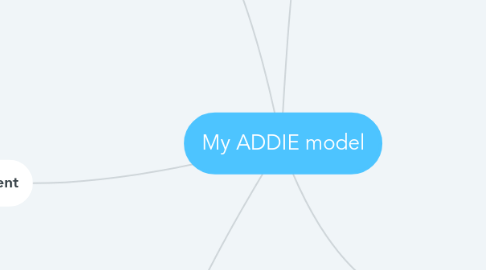
1. Develop
1.1. Create a sample of the content and get input from key stakeholders/clients
1.2. Develop the materials based on the Planning and Design phase
1.3. Conduct a run-through for Quality Assurance; a real-time rehearsal to test implementation, timing, functionality, etc.
1.4. Make corrections and adjustments as needed
2. Implement
2.1. Prepare all instructional staff
2.2. Prepare the learners so they the necessary tools, technology, resources and skills to take the course (ie, prerequisites)
2.3. Arrange and prepare everything necessary for the 'learning space" and all tools, resources needed whether its a physical space or an online space
3. Evaluation
3.1. Gather feedback and continually assess opportunities for improvement and better alignment of implementation with planning and development phases with core learning goals/objectives as the foundation of all decisions
3.1.1. Formative evaluation: occurs throughout the ADDIE process: Clarity, Impact, Feasibility
3.1.1.1. 1:1 evaluation: pilot testing the material on a single learner
3.1.1.2. Small group evaluation: determine effectiveness of changes and pilot test on a dynamic and diverse group similar to the target audience
3.1.1.3. Field trial to work out remaining issues and test on larger group
3.1.2. Summative evaluation
3.1.2.1. Learner reactions: subjective evaluations of each learner's experience with the course material
3.1.2.2. Post tests of learners knowledge, skills, attitudes
3.1.2.3. Behavioral assessments in the real world (more appropriate/relevant to professional trainings/settings)
3.1.2.4. Results: how well did the training/course impact short- and long-term outcomes? (also more appropriate/relevant to professional trainings/settings)
4. Analyze
4.1. Define Instructional Goals
4.2. Instructional analysis
4.2.1. Define the steps needed to meet your instructional goal(s), including available resources and tools
4.2.2. This is iterative, and will likely evolve as you move through the ADDIE process
4.3. Learner analysis
4.3.1. Define and understand your audience
4.3.2. Get a sense of where they are in the learning process (zone of proximal development = they all come to the learning environment with different levels of understanding of the subject matter)
4.4. Create specific learning objectives
4.4.1. What should the students be able to DO after completing the course?
4.4.2. Includes knowledge, attitudes, skills and behaviors
5. Design
5.1. 1. Design your assessments first!
5.1.1. Based on your instructional goals and learning objectives
5.1.2. How can you make them test more than just basic knowledge, but to assess higher-level learning, ie "task-oriented"
5.2. 2. Select the course format and delivery systems
5.2.1. Online only; onsite, written, blended, etc - many options and should be tailored to learning objectives and student analysis
5.3. 3. Map out your Instructional strategy, aligned to your learning objectives
5.3.1. Pre-instructional activities: motivate the learner, lets them see the value of the material and the relevance to the course learning objectives
5.3.2. Content presentation should be concise, directly relevant to course learning objectives; best to go beyond basic concepts and to include examples
5.3.3. Provide learners the opportunity for practicing the concepts and get feedback on their learning
5.3.4. Assessments: practice assessments, attitude assessments (ie, course or lecture evaluations) and the final assessment of a student's learning
5.3.5. Follow-through activities to internalize/synthesize/apply learning -- examples are culminating projects or written assignments on a topic of the students' choosing

